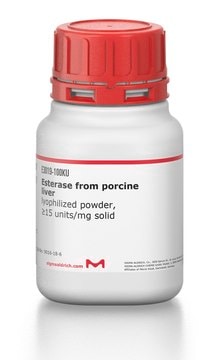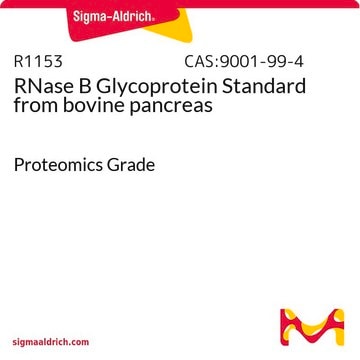The form of fetuin has not been determined. This material has not been sequenced. The minimum allowable sialic acid content is 0.5%. The molecular weight is approximately 44,200 daltons. The starting material for this product has a molecular weight of approximately 48,400 including an estimated 8.7% sialic acid. According to the UniPro values for each, the Fetuin-B molecular weight is calculated at 42,663 while the Fetuin-A is 38,419.
A4781
Asialofetuin from fetal calf serum
Type I (Sigma designation)
Sinonimo/i:
Asialofetuin
Scegli un formato
Scegli un formato
About This Item
Prodotti consigliati
Origine biologica
bovine (calf) serum
Livello qualitativo
Tipo
Type I (Sigma designation)
Stato
powder
Impurezze
salt, essentially free
≤0.5% N-acetylneuraminic acid
Solubilità
0.85% sodium chloride: soluble 1 mg/mL
Temperatura di conservazione
2-8°C
Cerchi prodotti simili? Visita Guida al confronto tra prodotti
Descrizione generale
Applicazioni
- to quantitate the plant Ricin toxin′s B subunit (RTB) lectin activity in β-phaseolin signal peptide (P)–proinsulin gene (INS)–RTB plants by enzyme-linked immunosorbent assay (ELISA)[2]
- quantitate VP7:RTB fusion protein in transformed potato tissues by ELISA[3]
- as a glycoprotein substrate to measure the receptor-binding activity of recombinant RTB and NSP490–RTB fusion proteins[4]
- to study the nature of the interaction between ferritin and the placenta[5]
Azioni biochim/fisiol
Nota sulla preparazione
Codice della classe di stoccaggio
11 - Combustible Solids
Classe di pericolosità dell'acqua (WGK)
WGK 3
Punto d’infiammabilità (°F)
Not applicable
Punto d’infiammabilità (°C)
Not applicable
Dispositivi di protezione individuale
Eyeshields, Gloves, type N95 (US)
Scegli una delle versioni più recenti:
Certificati d'analisi (COA)
Non trovi la versione di tuo interesse?
Se hai bisogno di una versione specifica, puoi cercare il certificato tramite il numero di lotto.
Possiedi già questo prodotto?
I documenti relativi ai prodotti acquistati recentemente sono disponibili nell’Archivio dei documenti.
I clienti hanno visto anche
-
To wich fetuin corresponds your product A4781 (Asialofetuin from fetal calf serum). Is it Protein Fetuin-A ? Uniprot entry: P12763 FETUA_BOVIN or protein Fetuin-B ? Uniprot entry: Q58D62 FETUB_BOVIN Do you have de amino acid sequence?
1 risposta-
Utile?
-
-
Hi, What is the difference in Type 1 versus Type II asialofetuin
1 risposta-
The difference between the Type I and Type II Asialofetuin products does not represent any kind of biochemical or functional difference. These indicate different methods of production and purification. The Type II option, product A1908, utilizes neuraminadase in an enzymatic cleavage step. The Type I, product A4781, uses a proprietary modification of that described in Spiro, R.G., J. Biol. Chem., 235, 2860 (1960).
Utile?
-
Filtri attivi
Il team dei nostri ricercatori vanta grande esperienza in tutte le aree della ricerca quali Life Science, scienza dei materiali, sintesi chimica, cromatografia, discipline analitiche, ecc..
Contatta l'Assistenza Tecnica.
















